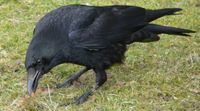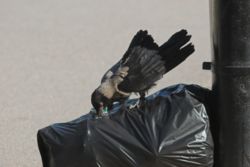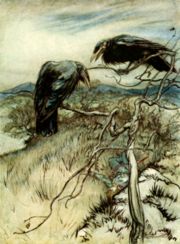|
Crow |

Carrion Crow
|
|
Scientific classification |
|
|
| Species |
|
See text. |
The true crows are in the
genus
Corvus. They are large
passerine
birds. All temperate
continents (except South America) and several offshore and
oceanic islands (including Hawai‘i) have representatives of the 40 or so members of
this genus.
Crows in the genus Corvus appear to have evolved in
central Asia and radiated out into North America, Africa,
Europe, and
Australia.
The latest
evidence appears to point towards an Australasian origin for
the early family (Corvidae) though the branch that would
produce the modern groups such as jays, magpies and large
predominantly black Corvus Crows had left Australasia and
were now developing in Asia. Corvus has since re-entered Australia
(relatively recently) and produced five species with one
recognized sub-species.
They range in size from the relatively small
pigeon-sized
jackdaws (Eurasian and Daurian) to the Common Raven of the
Holarctic region and Thick-billed Raven of the highlands of
Ethiopia.
In literary and fanciful usage, the
collective noun for a group of crows is a murder.
However, in practice most people, and especially scientists,
use the more generic term flock.
Systematics

Crow on a branch, Maruyama Kyo
(1733-1795)
There is no good systematic approach to the genus at
present. Generally, it is assumed that the species from a
geographical area are more closely related to each other
than to other lineages, but this is not necessarily correct.
For example, while the Carrion/Collared/House Crow complex
is certainly closely related to each other, the situation is
not at all clear regarding the Australian/Melanesian
species.
The
Neogene fossil record of crows is rather dense in Europe,
but the relationships among most prehistoric species is not
clear. Jackdaw-, crow- and raven-sized forms seem to have
existed since long ago and crows were regularly hunted by
humans up to the Iron Age, documenting the evolution of the modern taxa.
American crows are not as well-documented.
A surprisingly high number of species have gone
extinct after human colonization; the loss of one
prehistoric Caribbean crow could also have been related to
the
last ice age's climate changes.
Species
Australian and Melanesian species
-
Australian Raven C. coronoides
-
Forest Raven C. tasmanicus
- Relict Raven C. (t.) boreus
- Little Crow C. bennetti
Little Raven C. mellori
Torresian Crow C. orru
New Caledonian Crow C. moneduloides
Long-billed Crow C. validus
White-billed Crow C. woodfordi
Bougainville Crow C. meeki
Brown-headed Crow C. fuscicapillus
Grey Crow C. tristis
New Ireland Crow, Corvus sp. (prehistoric)
New Zealand species
- Chatham Islands Raven, C. moriorum (prehistoric)
New Zealand Raven, C. antipodum (prehistoric)
Pacific island species
- Mariana Crow, C. kubaryi
Hawaiian Crow or ‘Alala C. hawaiiensis (extinct in the
wild, formerly C. tropicus)
High-billed Crow, C. impluviatus (prehistoric)
Robust Crow, C. viriosus (prehistoric)
Tropical Asian species
- Slender-billed Crow C. enca
Piping Crow C. typicus
Banggai Crow C. unicolor (possibly extinct)
Flores Crow C. florensis
Collared Crow C. torquatus
Daurian Jackdaw C. dauricus
House Crow C. splendens
-
Large-billed Crow C. macrorhynchos
-
Jungle Crow C. (m.) levaillantii
Eurasian and North African species
- Brown-necked Raven C. ruficollis
Fan-tailed Raven C. rhipidurus
Jackdaw C. monedula
Rook C. frugilegus
-
Hooded Crow C. cornix
- Mesopotamian Crow, C. (c.) capellanus
- Carrion Crow C. corone
Corvus larteti (fossil: Late Miocene of France)
Corvus antecorax (fossil: Early - Late Pleistocene of
Europe; may be subspecies of Corvus corax
Corvus betfianus (fossil)
Corvus praecorax (fossil)
Corvus simionescui (fossil)
Corvus pliocaenus (fossil)
Corvus fossilis (fossil)
Corvus moravicus (fossil)
Corvus hungaricus (fossil)
Holarctic species
-
Common Raven C. corax
-
Pied Raven, C. c. varius morpha
leucophaeus (an
extinct color variant)
North and Central American species
- American Crow C. brachyrhynchos
Chihuahuan Raven C. cryptoleucus
Fish Crow C. ossifragus
Northwestern Crow C. caurinus
Tamaulipas Crow C. imparatus
Sinaloan Crow C. sinaloae
Jamaican Crow C. jamaicensis
White-necked Crow C. leucognaphalus
Hispaniolan Palm Crow C. palmarum
Cuban Palm Crow C. minutus
Cuban Crow C. nasicus
Puerto Rican Crow C. pumilis (prehistoric; possibly a
subspecies of C. nasicus/palmarum)
Corvus galushai (fossil: Big Sandy Late Miocene of
Wickieup, USA)
Corvus neomexicanus (fossil: Late Pleistocene of Dry
Cave, USA)
Tropical African species
- Cape Crow C. capensis
Pied Crow C. albus
Somali Crow or Dwarf Raven C. edithae
Thick-billed Raven C. crassirostris
White-necked Raven C. albicollis
In addition to the prehistoric forms listed above, some
extinct
chronosubspecies have been described. These are featured
under the respective species accounts.
For more information regarding relatives of the crows,
such as magpies and jays, see
Corvidae.
Behavior
Calls
Crows make a wide variety of calls or vocalizations.
Whether the crows' system of communication constitutes a
language is a topic of debate and study. Crows have also
been observed to respond to calls of other species; this
behavior is presumably learned because it varies regionally.
Crows' vocalizations are complex and poorly understood. Some
of the many vocalizations that crows make are a "caw",
usually echoed back and forth between birds, a series of
"caws" in discrete units, counting out numbers, a long caw
followed by a series of short caws (usually made when a bird
takes off from a perch), an echo-like "eh-aw" sound, and
more. These vocalizations vary by species, and within each
species vary regionally. In many species, the pattern and
number of the numerical vocalizations have been observed to
change in response to events in the surroundings (i.e.
arrival or departure of crows). Crows can hear sound
frequencies lower than those that humans can hear, which
complicates the study of their vocalizations.
Intelligence

Crow searching food from punctured wastebag
As a group, the crows show remarkable examples of
intelligence. They top the
avian IQ scale[1]. Crows and ravens often score very highly
on intelligence tests. Crows in the northwestern U.S. (a
blend of Corvus brachyrhynchos and Corvus caurinus) show
modest linguistic capabilities and the ability to relay
information over great distances, live in complex,
hierarchic societies involving hundreds of individuals with
various "occupations", and have an intense rivalry with the
area's less socially advanced ravens. One species, the New
Caledonian Crow, has recently been intensively studied
because of its ability to manufacture and use its own tools
in the day-to-day search for food. Wild hooded crows in
Israel have learned to use bread crumbs for bait-fishing.
Crows will engage in a kind of midair jousting, or
air-"chicken" to establish pecking order.
Crows have shown to
use traffic to crack nuts so they can collect their
food.
Color and society
Extra-specific uses of color in crow societies
Many crow species are all black. Most of their natural
enemies, the
raptors or "falconiformes",
soar high above the trees, and hunt primarily on bright,
sunny days when contrast between light and shadow is
greatest. Crows take advantage of this by maneuvering
themselves through the dappled shades of the trees, where
their black color renders them effectively invisible to
their enemies above, in order to set up complex ambush
attacks. Thus, their black coloring is of great strategic
importance to their societies. It is perhaps here where we
find the greatest difference between ravens and crows;
ravens tend to soar high in the air as raptors do, and
like raptors, are usually the target of ambushes by crows.
Crows do not appear to perceive ravens as their own kind,
but instead treat them as raptors.
While hawks tend to be the primary daytime predators of
crows, their most deadly predators, in many areas, are the
owls that hunt by night, preying upon crows sleeping
helplessly in their roosts. Presumably their dark color is
particularly helpful in blending into nighttime shadows.
Crows also will often mob owls much more fiercely when they
find them in daylight than they do hawks and other raptors.
Frequently crows appear to "play" with hawks, taking turns "counting
coup" while escorting the raptor out of their territory.
Their attacks on owls, on the other hand, possess a definite
serious quality.
Intra-specific uses of color in crow societies
Even in species characterized by being all black, one will
still occasionally find variations, most of which appear to
result from varying degrees of
albinism, such as:
- an otherwise all-black crow stunningly contrasted by
a full set of brilliant, pure-white primary feathers.
- complete covering in varying shades of grey
(generally tending toward the darker side)
- blue or red, rather than swarthy eyes (blue being
more common than red).
- Some combination of the above
The treatment of these rare individuals may vary from
group to group, even within the same species. For example,
one such individual may receive special treatment,
attention, or care from the others in its group, while
another group of the same species might exile such
individuals, forcing them to fend for themselves. The reason
for such behaviors, and why these behaviors vary as they do,
has yet to be studied.
Mythology and folklore

The Twa Corbies by
Arthur Rackham
Crows, and especially
ravens, often feature in legends or mythology as
portents or harbingers of doom or death, because of their
dark plumage, unnerving calls, and tendency to eat carrion.
They are commonly thought to circle above scenes of death
such as battles. The Child ballad The Three Ravens depicts
three ravens discussing whether they can eat a dead knight,
but finds that his hawk, his hound, and his true love
prevent them; in the parody version The Twa Corbies, these
guards have already forgotten the dead man, and the ravens
can eat their full. Their depiction of evil has also led to
some exaggeration of their appetite. In Pirates of the
Caribbean: Dead Man's Chest, The Omen II and Exorcist: The
Beginning, crows are shown tearing out people's eyes while
they are still alive. This, of course, does not happen as
crows can distinguish between carrion and living people.
In Native American folklore, Crow is often seen as a
similar trickster to Coyote. However, Crow's tricks tend to
be more out of malice and they rarely (if ever) are
portrayed as a hero. One possible explanation for this is
that crows are often considered a pest to crops, which the tribes who came up with the stories
featuring Crow needed to survive.
In the Epic of Gilgamesh, the Chaldean myth, the
character Utnapishtim releases a dove and a raven to find
land, similar to what Noah does in the book of Genesis. However, in the Epic of Gilgamesh, the dove
merely circles and returns. Only then does Utnapishtim send
forth the raven, who does not return. Utnapishtim
extrapolates from this that the raven has found land, which
is why it hasn't returned. This would seem to indicate some
acknowledgement of crow intelligence, which may have been
apparent even in ancient times, and to some might imply that
the higher intelligence of crows, when compared to other
birds, is striking enough that it was known even then.
In
occult circles, distinctions are sometimes made between
crows and ravens. In mythology and folklore as a whole,
crows tend to be symbolic more of the spiritual aspect of
death, or the transition of the spirit into the afterlife,
whereas ravens tend more often to be associated with the
negative (physical) aspect of death. However, few if any
individual mythologies or folklores make such a distinction,
and there are ample exceptions. Another reason for this
distinction is that while crows are typically highly social
animals, ravens don't seem to congregate in large numbers
anywhere but a) near carrion where they meet seemingly by
chance, or b) at cemeteries, where large numbers sometimes live together,
even though carrion there is no more available (and probably
less attainable) than any road or field.
Amongst Neopagans, crows are often thought to be highly
psychic and are associated with the element of ether or
spirit, rather than the element of air as with most other
birds. This may in part be due to the long-standing occult
tradition of associating the color black with "the abyss" of
infinite knowledge (see akasha), or perhaps also to the more
modern occult belief that wearing the "color" black aids in
psychic ability, as it absorbs more electromagnetic energy,
since surfaces appear black by absorbing all frequencies in
the visible spectrum, reflecting no color.
Gods and goddesses associated or identified with crows
and ravens
A very incomplete list includes the eponymous Pacific
Northwest Native figures Raven and Crow, the ravens Hugin
and Munin, who accompany the Norse god Odin, the Celtic
goddesses the Mórrígan and/or the Badb (sometimes considered
separate from Mórrígan), and Shani, a Hindu god who travels astride a crow. In Greek
mythology, it was believed that when the crows gave bad news
to the goddess Athena, she flew into a rage, and cursed
their feathers to be black.
Interesting Crow Facts
The American crow is very susceptible to the West Nile
virus, a disease just recently introduced in North America.
American crows usually die within one week of acquiring the
disease with only very few surviving exposure. Crows are so
affected by the disease that their deaths are now serving as
an indicator of the West Nile Virus’ activity in an area.
The American crow can address problems using several
solutions showing great problem solving skills. American
crows can also count!
Read more
About The Crow
See also
References
- Gill, B. J. (2003): Osteometry and
systematics of the extinct New Zealand ravens (Aves:
Corvidae: Corvus). Journal of Systematic
Palaeontology 1: 43-58.
DOI:10.1017/S1477201903001019
(HTML abstract)
- Worthy, Trevor H. & Holdaway, Richard
N. (2002): The lost world of the Moa: Prehistoric
Life of New Zealand. Indiana University Press,
Bloomington.
ISBN 0-253-34034-9.
External links




